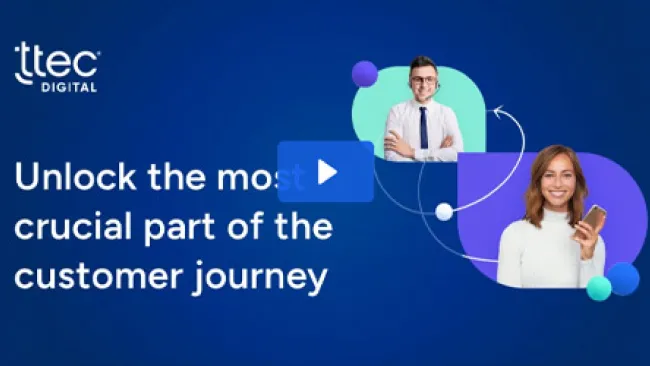Customer centricity can't be forced. It must be simply a part of the company. It's a mix of culture, organization, operations, and the company mission. It's the unwritten rule that everyone knows to follow.
A truly customer-centric business is one where organizational strategy, execution, and culture are focused on the customer. Just as with humans, organizations are made up of DNA, the foundational elements that make the company what it is. For customer-centric companies, that DNA contains decisions and attitudes that revolve around the customer.
But how does that happen? Based on our experiences helping firms with their customer efforts, we believe there are three critical internal building blocks that create an environment that breeds natural customer centricity. True customer DNA is made up of the following:
Data: All customer-centric operations begin with knowing your customer. Data is a critical element to understanding who your customers are, as well as what value and potential they may have. The "Data" part of DNA means converting customer information into actionable insight and using it to make decisions that work for the customer as well as the business.
Nature: A customer-focused company is one where all operations and processes have a customer connection. The structure of the organization—the IT systems used, the staff hired, the products developed, etc.—is created with the customer in mind. Even metrics and incentives must relate to the advancement of the customer relationship. The entire nature of a company is one where customers are a priority.
Attitude: People make up a culture, and their attitudes will make or break any customer-based initiative. Customer focus must be baked into the company even before the hiring process takes place. Employee personalities and behaviors such as empathy, kindness and listening are to be encouraged and rewarded. Employees all across the organization, both customer-facing and not, understand that their customer orientation will feed momentum around customer initiatives.
These three simple elements are the root of all customer-focused companies. They are essential pieces upon which all customer-based strategy and activity is built. Without being ingrained into every aspect of the business, customer initiatives may only exist in random pockets of an organization. Their impact will not reach their fullest potential. With them, a firm has the foundation on which to build a financially viable business model with the customer at the center.
Though all companies share these common elements, each individual organization must implement them in its own differentiated way, based on its brand promise, business model, customer base, and other unique attributes. A bank that promises to use technology to enable customer centricity must deliver on that promise, for example. The strategy, execution, and culture must be based on customer DNA aligned to deliver on the promise. Customers who are automatically pre-approved can begin a loan application on a mobile app, then seamlessly move to other channels to finish it, for example. Or advanced transactions may be offered via the ATM, which are captured and accessible to the relationship manager assigned to that individual.
Meanwhile, a bank that differentiates its brand through convenience may have a different strategy, execution and culture, but its backbone DNA is the same. Perhaps this bank has extended branch hours, simple credit card applications, or a contact center where live associates answer the phone.
In both of these cases, each bank uses customer data to inform aspects of the business and anticipate customer needs, employs a staff with strong customer service skills, and makes technology decisions based on customer benefit along with cost and efficiency. How each chooses to deliver its brand promise may differ, but the foundational elements that drive those decisions remain the same.
Each firm must look within itself to find the right way to grow via customer-focused DNA. Look at what you stand for as an organization, and break it down into different components. How will your organization design its business around customers? What customer data is important for actionable insight? How will you configure different departments and the organization at-large to build momentum by celebrating small victories? Each company must find its own path when it comes to realizing the potential of customer-centric DNA within its business.
Nature versus nurture
DNA is what makes people what they are. Either you have a specific DNA or you don't. The same applies for companies. So can it be changed? Can traditional companies shed their old ways and transform the essential elements of their business? The answer is yes. Just as with human evolution, company DNA can change over time as it evolves to be more customer-centric.
The companies with the fittest business will survive. Those that are willing to adapt to the changing environment around them will succeed. But it requires transformation from a company's core, not just superficial activities. Like human evolution, it is a difficult process that takes a long time to come to fruition.
Newer companies have the advantage in this area, because they can instill customer centricity into the fibers of their being from their inception. Companies like Amazon, Zappos, and Google designed their entire business around customers, and their success has spurred attention to customer focus across all industries. But even more traditional companies like USAA, Nordstrom, and American Express have consistently made fundamental changes to their operations to adapt to evolving market conditions and customer expectations. Adjusting business philosophy is hard, but it is possible, and necessary for survival over the long term.
Barriers to creating customer-centric DNA
Many companies talk about being customer-centric, but few actually embed it into their company DNA. The concept is as old as commerce itself: understand your customers, create a strategy based on that understanding, and configure your organization so it benefits both the customer and the company. What has changed is the technology and the scale of a company's ability to see the concept through to reality.
Executives like to tout buzzwords like CRM, social media, loyalty, satisfaction, and advocacy to prove that their companies are committed to customers. But many stop there. And when it comes to customers, talk and action are very different.
Many senior leaders understand the concepts and importance of customer centricity, but not how to implement it within their organizations. Lack of understanding is a difficult barrier to overcome. After all, big picture customer-centric ideas are hard to communicate and tie to the daily workday. It's a macro-level issue requiring long-term strategy and cross-functional participation. Yet most people spend their time focusing on micro-level projects that they can control and that achieve results quickly. And in many cases, customer-focused projects do not easily align with overall business strategy, especially if overall business strategy has a product focus.
In addition, it's often a struggle when IT and business departments meet. Communication between them can be difficult. They tend to have different viewpoints on the same issue, and different perspectives on how to achieve a goal. In many cases, one group eventually overrides the other, which creates a suboptimal environment for everyone. But real customer centricity requires both groups to work together to enable technology that gets to customer-centric business goals.
And of course, changing a company's culture is not something that can be achieved overnight. Resistance and inertia for any project can be tough challenges to overcome. When you want to realign an entire business, expect more than a few naysayers.
Recommendations
So, how can executives overcome these challenges and enact customer-centric evolution? It requires strong leadership and structured focus on the three components of company DNA. First, establish a baseline for your organization's Data, Nature, and Attitude. What works? What needs improvement? Then create short- and long-term plans on how to implement change in each department and across the entire organization along the DNA spectrum. Include voices from around the company, so the plan is representative of the entire firm. Small wins are important to build momentum and organically develop customer centricity. Lead by example, from both the top down and, when possible, the bottom up. In addition, it's critical to match performance metrics and incentives to the program at-large, to maintain clarity of purpose in both words and actions.
In some cases, a formal change management program may be necessary. Culture change may be the most difficult aspect of the transformation, but once employees embrace a new culture, it will naturally drive momentum. Customer centricity can't be manufactured. But if done properly, customer centricity won't be something that needs a project management team. It will occur naturally in all areas of the business, both presently and in all future projects. When that happens, you know evolution has occurred. You will be fit to survive by literally having customers at the heart of your business.
















